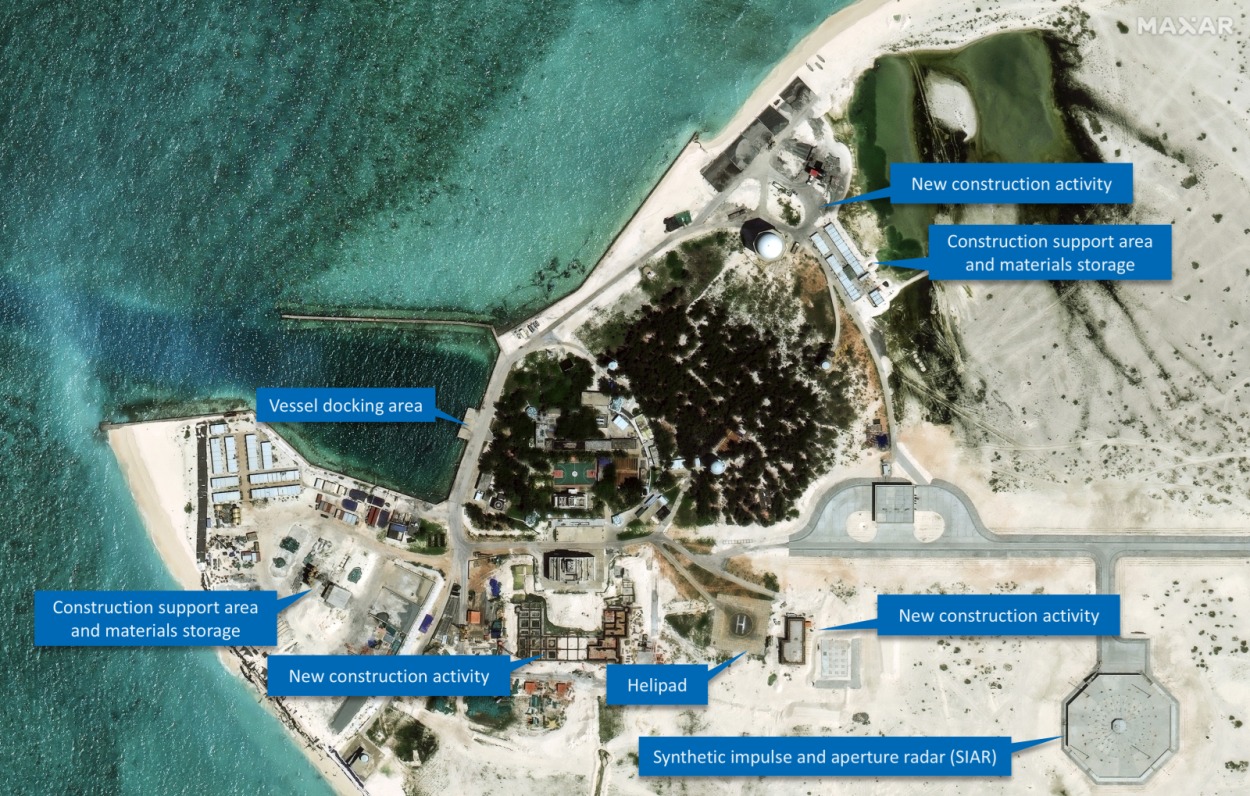Recent satellite imagery reveals a significant military buildup on Triton Island, the closest landmass in the disputed Paracels archipelago to Vietnam.
According to ‘the Royal Institute of International Affairs,’ also known as ‘Chatham House’ – a British think tank based in London, this strategic location is set to become one of Beijing’s primary signal intelligence bases in the South China Sea, reflecting China’s broader ambitions in the region.
Enhancing Surveillance Capabilities
Satellite imagery suggests that the Chinese military is reportedly constructing a new counter-stealth radar system on a disputed reef in the South China Sea, which would greatly enhance its surveillance capabilities in the area.
The presence of this new radar system at China’s Triton Island military base indicates that Beijing is swiftly advancing its intelligence capabilities in these contested waters.
Once operational, the radar will significantly bolster China’s signal interception and electronic warfare abilities across the Paracel Islands and contribute to a broader surveillance network across much of the South China Sea.
Chatham House’s analysis indicates that China is upgrading its outpost and potentially establishing a launching point for an anti-ship missile battery alongside the advanced radar system.
Similar counter-stealth radars, known as SIAR (synthetic impulse and aperture radar), have already been established to the south on Subi Reef in the Spratly Islands and to the north on Hainan Island. The development at Triton Island will fill a critical gap in China’s radar coverage.

A New Airstrip On Triton Island
Adding to the military infrastructure, reports emerged just two months ago, in August, about a new airstrip being constructed on Triton Island.
The report suggests that the airstrip is relatively short and narrow, measuring just over 2,000 feet long and about 45 feet wide. It could potentially accommodate short take-off and landing (STOL) fixed-wing aircraft, turboprops, light planes, and even helicopters or drones.
The purpose of this airstrip remains uncertain, but it could crucially boost logistics for military operations. In addition to the airstrip, satellite images reveal a large new work area that includes a cement plant, which could significantly enhance logistics on the most western inhabited island of the Paracel archipelago.
This development has occurred rapidly over the last few months. Previously, the Chinese outpost featured an observation station with two radomes and several large flags but little else. The island was also equipped with a small harbor and a helipad.
Strategic Importance Of Triton Island
Located in the Paracels — known as the Xisha Islands in China — Triton Island is effectively controlled by Beijing but is also claimed by Vietnam and Taiwan.
China took control of the Paracels from South Vietnam following a 1974 naval clash. (North and South Vietnam formally reunified in 1976) Since then, and especially after the discovery of oil and gas reserves in the surrounding waters, competition for control has intensified. In 2014, Chinese and Vietnamese maritime forces clashed near Triton’s waters.
The Paracel Islands chain, which comprises around 30 islands and over 100 reefs, banks, and other maritime features, has witnessed significant Chinese military developments in recent years. China’s expansion of facilities in the Paracels is part of a broader strategy to strengthen its presence and capabilities throughout the South China Sea.
Today, the South China Sea is dotted with fortress-like, largely man-made outposts established on various shoals and reefs, many of which were previously uninhabitable.
This expansion aligns with Beijing’s claims over nearly the entire region as its sovereign territory—claims that the vast majority of the international community disputes, leading to increased tensions with neighboring countries.
Woody Island: A Blueprint for Expansion
The development of Triton Island can be compared to Woody Island, also known as Yongxing Island, which serves as a model for China’s expansion and military strategy in the South China Sea.
Woody Island, the largest in the Paracels, is about 200 miles south of Hainan and is also claimed by Taiwan and Vietnam.
It serves as an advanced intelligence base for the People’s Liberation Army (PLA), hosting fighter jets, long-range bombers, and other military assets.
For example, in November 2020, China deployed an H-6J missile-carrying bomber to Woody Island, following earlier visits by PLAAF H-6K bombers in 2018, which demonstrated the island’s capacity to accommodate larger aircraft.
According to the CIA World Factbook, Woody Island is currently China’s primary military hub in the Paracels. It is equipped with extensive installations that include an airstrip with fighter hangars, naval facilities, surveillance radars, and advanced defensive systems such as surface-to-air and anti-ship cruise missiles.
Given Woody Island’s development as a model, Triton Island appears poised to become a critical asset in Beijing’s growing South China Sea intelligence and defense network.
China’s Island Chain Strategy
Deploying surface-to-air and surface-to-surface missile systems on Triton Island, along with surveillance assets, would add a significant anti-access/area-denial (A2/AD) layer for China, positioned within 150 miles of Vietnam’s coastline.
This capability would not only enable the PLA to closely monitor Vietnamese military operations, including its Su-30 Flankers but would also extend China’s A2/AD ‘bubble’ over Vietnamese territory, intensifying the strategic tension in the region.
Despite strong trade ties and historical military cooperation, the territorial disputes between China and Vietnam in the South China Sea continue to represent a significant flashpoint in regional stability.
China’s growing military presence in the South China Sea will complicate the strategic landscape for regional competitors and heighten concerns among neighboring nations, leading to greater scrutiny and potential responses.
The American commitment to a “free and open Indo-Pacific” continues to challenge Beijing’s territorial claims along with British and Australian naval forces, which have patrolled these waters for over a decade to contest China’s ‘nine-dash line.’
Strengthening Control
The military buildup on Triton Island represents a significant escalation in China’s strategy to establish military dominance in the South China Sea.
By following the Woody Island development model and incorporating advanced surveillance and defensive capabilities, China is creating a comprehensive military network that strengthens its territorial claims and projects power throughout the region.
China’s expansion has serious implications for regional stability and international maritime freedom.




